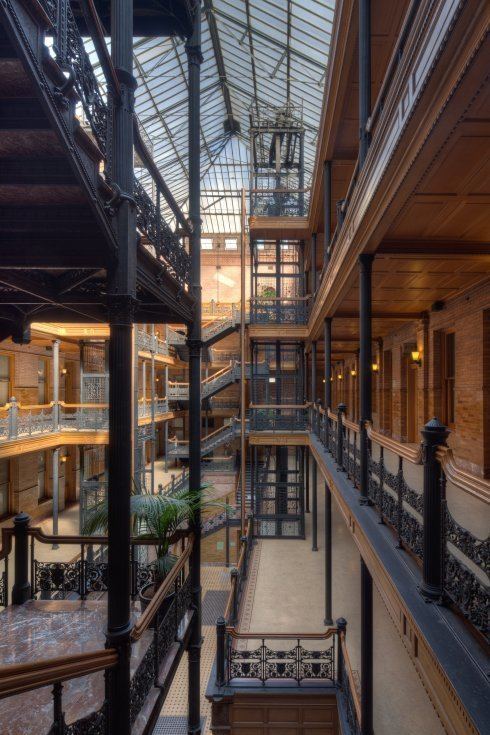Occupation Architect Name Sumner Hunt | Role Architect | |
 | ||
Practice Sole practitioner, and in partnerships of:Eisen and Hunt (1895−1899),Hunt and Eager (1899−1907),Hunt and Burns (1908−1930) Projects Los Angeles region, California Design Historicist−Revival architecture styles Died November 19, 1938, Los Angeles, California, United States Structures Bradbury Building, Casa de Rosas, Scottish Rite Cathedral, Vermont Square Branch | ||
Sumner P. Hunt (Brooklyn, NY, May 8, 1865 – Los Angeles, CA, November 19, 1938) was an architect in Los Angeles from 1888 to the 1930s. On January 21, 1892, he married Mary Hancock Chapman, January 21, 1892. They had a daughter Louise Hunt.
Contents
Life and career
Hunt initially apprenticed with and worked for Clarence B. Cutler in Troy, NY from 1879–1887, and in his later career made claim to having worked in Cutler’s office in New York City from 1888 to 1889. However, New York City directories make no mention of a Sumner Hunt as city resident and do not include a business listing for Clarence Cutler Architects during those two years. The 1888 Los Angeles City Directory lists Hunt as a resident, living in a rooming house on the east side of Hill Street north of Fifth Street.
In Los Angeles, he worked for Eugene Caulkin and Sidney I. Haas (designers of the 1889 Los Angeles City Hall) from 1888–1889. He supervised construction of City Hall for Caulkin and Haas. Following the building's completion he established his own practice in 1891 in the California Bank Block at 2nd Street and Broadway, the year he was hired by Louis Bradbury to design the Bradbury Building. In 1895, Hunt formed a partnership with Theodore A. Eisen. Eisen & Hunt continued until 1899.
Hunt was hired by Bradbury sometime in 1891. Bradbury had purchased the parcel at the Third and Broadway intersection on November 11, 1890. In the first week of October 1891, the building which housed an Eckstein's Drug Store was picked up, moved around the southern toe of Prospect/Bunker Hill and set on a new foundation at the northwest corner of Third and Flower. Eckstein had had the city's very first telephone, incidentally. Sumner Hunt designed Bradbury's office building during the fall of that year and secured a general building permit on December 15. His last recorded involvement in the project was in pulling a foundation permit on the following 9 March. Meanwhile, on or about February 8th, Bradbury called in Hunt, requested that he bring the building's plans with him and when they met, Bradbury terminated his services without complaint. The L.A. City Directory for 1892 indicates that Wyman was then operating an office in the Stowell Block on the east side of Spring Street north of Third. There is no record of his ever having worked for Hunt, other than the suspect allegation by Wyman's daughters and grandson made to Esther McCoy in 1953. The March 1892 edition of 'Illustrated Herald of Los Angeles included Hunt's perspective rending of the Bradbury Building and made specific mention of a 45 ft. by 120 ft. interior court. As well, the 1896 edition of 'Los Angeles of Today Architecturally' credits Hunt with the design of the building.
In 1899, Hunt went into partnership with A. Wesley Eager. Hunt & Eager lasted until 1908, at which point Silas Reese Burns joined the firm, which became Hunt, Eager & Burns. In 1910 Eager retired, and the firm became known as Hunt & Burns, a partnership that lasted until 1930.
In her essay on Hunt's early work, Karen J. Weitze notes that he may have been involved in the design of Sidney Haas’s Moorish- and Mission-revival designs for the California Building at the 1893 World’s Columbian Exposition in Chicago. Hunt adopted the Mission Revival style for the Froebel Institute, also known as Casa de Rosas (1893), and “became a leading proponent of Hispanicism, a fact that was clearly reflected in his Southern California Building at the California Midwinter Exhibition” in 1894.
Hunt joined Charles Lummis and the architect Arthur B. Benton in 1894 to found the California Landmarks Club, with the purpose of saving Southern California’s mission buildings. The following year Lummis mentioned some of Hunt’s architecture in an article in Land of Sunshine, in which he advocated for turning Los Angeles from a beautiful city into a picturesque one. In the same article Lummis attributed the plan of the Bradbury building to Hunt.
Practice
Projects designed by Hunt, and by his architectural partnerships, include:
The Press Reference Library (Los Angeles: Los Angeles Examiner, 1912), p,. 82, lists the following buildings for Hunt, although he very likely designed them in partnership:
According to Our Architecture: Morgan & Walls, John Parkinson, Hunt & Eager, compiled by J. L. Le Berthon (Los Angeles, CA: J. L. Le Berthon, 1904), Hunt & Eager were responsible for the following structures:
